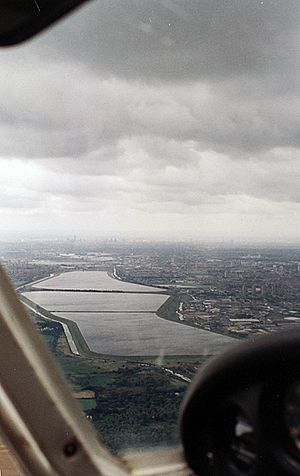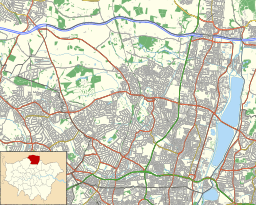William Girling Reservoir facts for kids
Quick facts for kids William Girling Reservoir |
|
|---|---|

The reservoir viewed from Chingford
|
|
| Location | London Borough of Enfield |
| Coordinates | 51°37′54″N 0°01′28″W / 51.6316°N 0.0244°W |
| Type | reservoir |
| Primary inflows | River Lee Diversion |
| Basin countries | United Kingdom |
| Surface area | 135 ha (330 acres) |
| Max. depth | 12.5 m (41 ft) |
| Water volume | 16.5 Gl (3.6×109 imp gal) |
The William Girling Reservoir is a large lake built by people to store water. It is located in the London Borough of Enfield in England. This reservoir is part of a group of reservoirs called the Lee Valley Reservoir Chain. These reservoirs help supply clean drinking water to the city of London.
The reservoir is named after William Girling OBE. He was an important leader of the Metropolitan Water Board (MWB). This board was in charge of London's water supply. The William Girling Reservoir and the nearby King George V Reservoir are together known as the Chingford Reservoirs. Thames Water, a company that provides water, owns this reservoir. It is bordered by Chingford to the east and Ponders End and Edmonton to the west. The reservoir covers about 135 hectares (334 acres) and has a perimeter of 5.6 kilometers (3.5 miles). For safety reasons, people are not allowed to visit the reservoir directly.
Contents
History of the Reservoir

The idea for this reservoir came about in 1893. It was part of a bigger plan for the Lea Valley area to improve London's water supply. At that time, a company called the East London Waterworks Company was responsible for the project. However, in 1902, the job of supplying water to London was given to a new organization, the Metropolitan Water Board (MWB).
Building the Reservoir
Construction of the William Girling Reservoir started in 1936. A company called John Mowlem won the contract to build it. A civil engineer named Robert Wynne-Edwards led the project. The builders used new machines like mechanical scrapers and bulldozers for the first time in British dam construction. This helped them work very quickly.
The reservoir's design was created by Sir Jonathan Roberts Davidson. In 1937, something unexpected happened during construction. A large part of the partly built wall, called an embankment, slipped. This happened before any water was stored, which was lucky. Experts were called in to figure out why it happened. Two soil mechanics experts, Dr. Herbert Chatley and Professor Karl Terzaghi, gave advice. Based on their recommendations, the Metropolitan Water Board changed the original design in 1938. This event was very important for the study of how soil behaves in construction in Britain. The new design also made the reservoir bigger, increasing its capacity by 11.3%.
Delays and Opening
Building the reservoir was further delayed by the start of the Second World War. It was finally finished in 1951. On September 4, 1951, William Girling, who was the Chairman of the MWB, officially opened the reservoir. It was named after him to honor his work.
In 2012, during security preparations for the 2012 Summer Olympics, the reservoir was chosen as a place to set up Rapier surface-to-air missiles. These missiles help protect the area from threats from the sky.
How the Reservoir Works
The ground under the reservoir is made up of different layers. There is alluvium (soil deposited by water) on top, then river gravels, and finally a layer of London Clay.
The Embankment
The reservoir is surrounded by a continuous earthen wall called an embankment. This wall holds the water inside. The embankment has a central core made of puddle clay. This clay core is like a waterproof barrier. It is thickest at the bottom (about 3.7 meters or 12 feet) and gets thinner towards the top. The clay core goes about 0.9 meters (3 feet) into the London Clay layer below to make sure no water can leak out.
The outer parts of the embankment are made of ballast and other filling materials. The slopes of the upper embankment are not very steep, making them stable.
Water Inflow
Water is pumped into the reservoir from the River Lee Diversion. There are five pumps that can bring in a lot of water, up to 600 million liters per day. However, they usually pump about 250 million liters per day.
There are also two smaller inlets that bring water from a special underground water system called the North London Artificial Recharge borehole scheme.
Water Outflow
The water leaves the reservoir through an outlet tower. This tower has a large vertical pipe, about 1.4 meters (54 inches) wide. Water can be drawn off from four different levels in the reservoir. The bottom of this pipe connects to a steel conduit (a pipe for carrying water) that is about 1.3 meters (50 inches) wide.
The water then travels to the Coppermills Water Treatment Works. Here, the water is cleaned and made safe for drinking. From there, it can also be sent to Essex and Suffolk Water, another water company.
Wildlife and Nature
The William Girling Reservoir is part of the Chingford Reservoirs Site of Special Scientific Interest (SSSI). This means it is a very important place for nature. It is a major winter home for many wildfowl (like ducks and geese) and other wetland birds. Many species of birds come here in large numbers, making it nationally important.
The reservoir also provides a safe place for a large number of wildfowl to moult (shed their feathers) during the late summer. In recent years, 85 different types of wetland birds have been seen at the reservoir.


